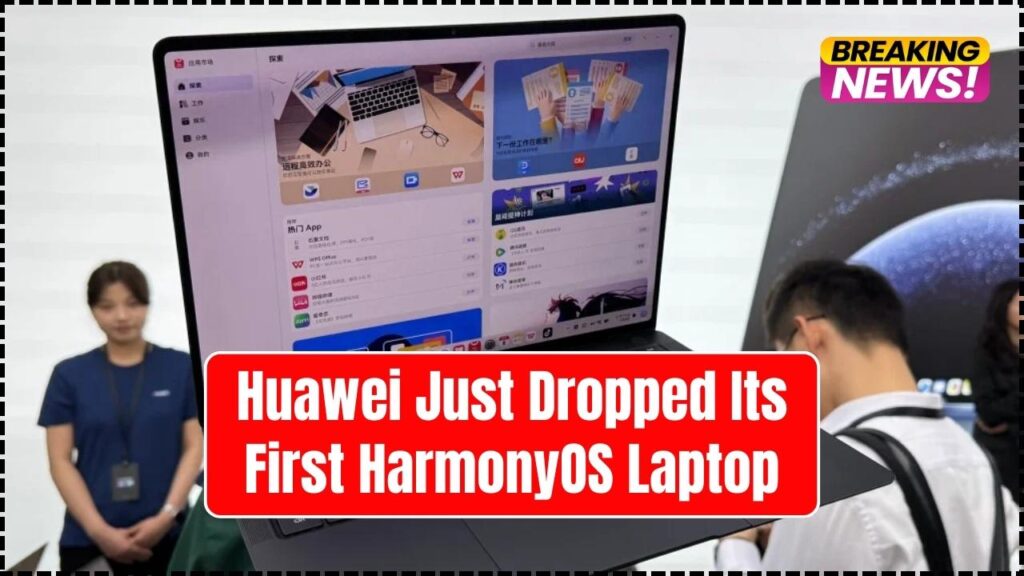Huawei Just Dropped Its First HarmonyOS Laptop: Huawei has officially launched its first laptops powered by HarmonyOS, marking a significant milestone not just for the Chinese tech giant but for the broader computing industry. This bold move comes at a time when global tensions around tech sovereignty and supply chain independence are shaping the strategies of top-tier manufacturers.

The release of the MateBook Fold Ultimate Design and MateBook Pro, both running HarmonyOS 5, signals Huawei’s determination to create a self-reliant and competitive computing ecosystem. Here’s a detailed look at why this matters and what you need to know.
Huawei Just Dropped Its First HarmonyOS Laptop
| Feature | Details |
|---|---|
| Device Names | MateBook Fold Ultimate Design, MateBook Pro |
| Operating System | HarmonyOS 5 |
| Key Technologies | AI assistant Celia, multitasking UI, Super Device integration |
| MateBook Fold | 18″ OLED foldable screen, 1.16kg weight, folds into 13″, up to 32GB RAM, 2TB storage |
| MateBook Pro | 14.2″ OLED, 3:2 aspect ratio, up to 32GB RAM, 2TB SSD, 970g weight |
| Pricing (China) | Fold: ¥23,999 ( |
| Apps Supported | 150+ including WPS Office, Meitu Xiu Xiu |
| Launch Significance | Huawei’s response to US sanctions; a leap toward self-reliant PC infrastructure |
| Official Website | huawei.com |
Huawei’s launch of HarmonyOS-powered laptops is a game-changer for the PC industry. While the devices may not yet threaten Windows or macOS in global market share, they represent a pivotal shift in how tech companies adapt to political and logistical realities.
With bold design, in-house software, and a clear focus on building an independent ecosystem, Huawei is laying the groundwork for the future of computing beyond traditional boundaries.
As this ecosystem matures, and if HarmonyOS continues to scale, it could become a serious third contender in a market long dominated by Microsoft and Apple.
Why Huawei Just Dropped Its First HarmonyOS Laptop Matters
Huawei’s new laptops are more than just sleek hardware—they represent a strategic shift in the global tech landscape. Since being placed on the U.S. Entity List in 2019, Huawei has faced restrictions that prevent it from using key U.S.-made components and software, including Windows OS and Intel chips.
In response, the company has doubled down on its in-house technologies, including HarmonyOS (for software) and the development of its own chips. The HarmonyOS laptop is Huawei’s most ambitious step yet toward full-stack independence.
Overview of the Devices
MateBook Fold Ultimate Design
This device stands out as Huawei’s first foldable laptop. It boasts:
- A massive 18-inch OLED display when unfolded
- Converts into a 13-inch form factor with an on-screen keyboard
- Ultra-thin profile: 7.3mm when open, 14.9mm when folded
- Lightweight: 1.16kg, despite large display size
- Storage up to 2TB SSD, 32GB RAM
- A 3.3K resolution display with up to 1600 nits brightness
- A starting price of ¥23,999 (~$3,328)
This laptop is ideal for professionals, creatives, and travelers who want power, portability, and cutting-edge design in one machine.
MateBook Pro
The more traditional form factor still brings plenty of innovation:
- 14.2-inch OLED display, 3:2 aspect ratio
- Ultra-light at 970 grams
- Up to 32GB RAM and 2TB SSD for performance-heavy applications
- Priced starting at ¥7,999 (~$1,110)
- Seamlessly integrates with other Huawei devices using Super Device
What is HarmonyOS 5?
HarmonyOS 5 is Huawei’s proprietary operating system, built on a microkernel architecture that enhances security, flexibility, and performance. While earlier versions of HarmonyOS targeted mobile and IoT devices, version 5 is fully optimized for desktop and laptop experiences.
Key Features:
- Desktop-style UI: Includes taskbar, start menu, file manager
- Multitasking: Support for resizable, movable windows
- AI Integration: HarmonyOS features Celia, Huawei’s smart assistant
- ross-device Compatibility: Connects with Huawei smartphones, smartwatches, tablets seamlessly
- App Ecosystem: Over 150 apps available, growing daily
Developers can build HarmonyOS apps using Huawei’s Ark Compiler and DevEco Studio, which simplifies cross-platform deployment.
Ecosystem Integration: One OS, Many Devices
One of HarmonyOS’s key strengths is its ability to create a cohesive experience across device types. Huawei’s Super Device ecosystem enables:
- Drag-and-drop file sharing across devices
- Shared clipboard and screen mirroring
- Multi-device collaboration with tablets and monitors
This interconnectedness rivals Apple’s macOS and iPadOS synergy, offering users a unified Huawei experience.
iQOO Neo 10 Launching in India on May 26 — Everything You Need to Know
Microsoft to Update Windows 11 With New Start Menu and AI Features Soon
Vivo Y300 GT Launched With 7620mAh Battery and MediaTek Chip — Check Price and Specs
A Bold Step Toward Technological Sovereignty
Huawei’s shift to HarmonyOS on laptops signals a major transformation in its operating model. It’s not just avoiding U.S. sanctions—it’s building an entire technology stack from the ground up.
This includes:
- Proprietary chipsets (Kirin series)
- Self-built operating systems (HarmonyOS, EulerOS for enterprise)
- In-house cloud services and AI development
For China’s broader national tech ambitions, Huawei is a flagship case of resilience and innovation under pressure.
FAQs On Huawei Just Dropped Its First HarmonyOS Laptop
Q1. Can HarmonyOS run Windows apps?
Not natively. However, Huawei may offer compatibility layers or encourage equivalent app development in its AppGallery.
Q2. Will these laptops be available outside China?
For now, availability is limited to China. Global launch may follow based on app ecosystem readiness.
Q3. How does HarmonyOS compare to Windows or macOS?
It offers a sleek UI and robust multitasking but still lacks the vast software library of its competitors. However, it is rapidly evolving.
Q4. Can developers publish apps on HarmonyOS?
Yes, via Huawei Developer Portal. Huawei provides SDKs and support for integration.
Q5. Is this a Linux-based system?
HarmonyOS is not Linux-based. It uses a custom microkernel, unlike Android or traditional Linux distributions.
Implications for the Industry
Huawei’s release of a full-featured HarmonyOS laptop may influence other Chinese OEMs to explore non-Windows alternatives. This could:
- Diversify global OS offerings
- Accelerate innovation in UI/UX design
- Encourage open-source OS development (e.g., Linux forks, microkernel systems)
It also puts pressure on traditional OS makers like Microsoft and Google to expand localization and support outside of Western markets.






